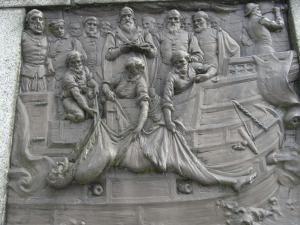History of Death
"So violent a squall was sweeping past the ship at this moment, that no sound was heard of the usual splash, which made the sailors allege that their young favourite never touched the water at all, but was at once carried off in the gale to his final resting place! "Herman Melville, on a sea burial in 1843
Ancient Sea Burials
Burial at sea is thought to have taken place throughout history, with instances dating back as far as Ancient Egypt, Greece and Rome, alongside the traditional funerary rites of these civilisations. The practice can indeed be found all around the world; in the South Pacific bodies would be placed in a red cloth and launched out to sea in a canoe. People in the Solomon Islands on the other hand would sometimes place their dead on the reefs surrounding the islands for sharks to consume. In much of Asia, scattering ashes at sea is still the norm, and for Hindus in India today it is customary to scatter or place ashes in the holy River Ganges.
Vikings
The Vikings were especially famous for their ship burials, bringing the practice to the British Isles when they invaded in 700A.D. These burials however often took place on land, with the ship either cremated or interred under a burial mound. In the Norse Sagas we hear of ashes being scattered over the sea, and through there is no physical evidence for the practice, stories tell of Viking ships being set alight and pushed out to sea to be consumed by the flames and waves.
British Burials at Sea
British seafarers and especially the British Navy often found it necessary to perform sea burials. While the French and Spanish traditionally preferred to leave the bodies of their comrades in the ship’s hold until such a time as they could find a land cemetery, the British developed their own ritualised sea burials quite early on. This often involved the body being stitched into a shroud by the ship’s sail maker or one of his mates, with one prevalent tradition dictating that the last stitch should pass though the corpse’s nose. In the 19th Century a dead sailor’s hammock was often used as a shroud instead. In both instances the body would be weighted down with lead shot to ensure it sank properly and did not find its way ashore. After being given a religious service presided over by the captain of the ship, the body would be tipped into the water feet first.
A common superstition amongst sailors, persisting right into the 19th century was that sea birds, such as storm petrels or albatross carried the souls of dead sailors, resulting in beliefs that it was extremely unlucky to do them any harm. One famous burial in the 18th Century was that of the explorer Captain Cook. The circumstances of Cook’s death were rather grizzly, after a disagreement with locals in Hawaii over a stolen boat Cook went ashore and was killed. The few parts his crew could recover were put in a coffin and given a sea burial with great ceremony.








